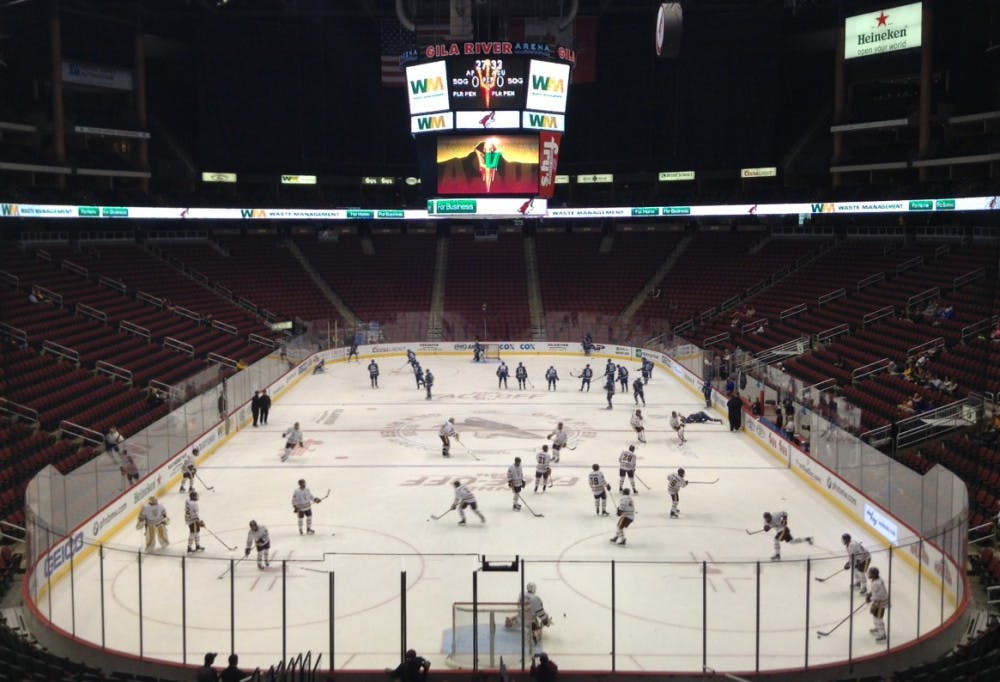The Arizona Coyotes’ newly-announced arena proposal is enormously good news for several stakeholders.
On Monday, the NHL franchise announced that they plan to build a 16,000-seat arena to be their new home, as well as an adjacent 4,000-seat arena to serve as the home of ASU hockey and Coyotes practices.
No plan is perfect. The proposed location, on the Northwest corner of Rio Salado and McClintock in Tempe, is now the back nine holes of ASU Karsten Golf Course. The course’s likely downsizing or closure is, obviously, not ideal for its employees or players.
Not only that, but taxpayer money would be required. And while some argue that it doesn’t make sense to use public money on sports arenas, a particularly bullish economic boost seems likely if the arena is built, given Tempe’s status as a growing market.
Some think it’s a mistake to use public funding for yet another venue where juvenile, overpaid athletes play a game.
I say it’s a mistake that the Arizona Coyotes ever moved to Glendale, hardly accessible but by helicopter during Phoenix’s peak rush hours.
Tempe is where this arena should have been built in the first place. It’s about time the Coyotes made the move out of an arena that’s currently under the purview of a hostile, unwelcoming Glendale City Council.
Here are some other reasons why building a brand new facility for the Valley’s two foremost hockey clubs is positive news:
1) Growth of ASU hockey
Now in its first full NCAA Division I season, Sun Devil hockey is in its infancy. A new arena, along with the Coyotes’ support in partnering with ASU athletics, would theoretically draw more attention to the program.
Coyotes fans that come to the bigger of the two venues may be inspired to catch a game inside the smaller one. Or, when college teams from the hometowns of many Phoenix transplants come to play ASU, there’s a shiny new venue enticing them to come watch.
2) Recruiting
ASU hockey head coach Greg Powers said earlier this month in an unrelated interview that when potential recruits come to town to tour the campus, they often raise two concerns:
“There’s only two,” he said. “It’s conference and it’s arena. That’s it.”
The Sun Devils currently play at Oceanside Ice Arena, a small facility on McClintock just north of this proposed site. It doesn’t quite compare to the homes of college hockey powerhouses back east.
Preview of Compton Family Ice Arena here in South Bend! #BeatND pic.twitter.com/TmD9GyFFC5
— Sun Devil Hockey (@SunDevilHockey) October 6, 2016
In a few years, if and when a new arena is constructed and ready for use, one could imagine that would extinguish one small roadblock in Powers’ recruiting ability. And while the allure of Tempe has helped attract strong recruiting classes already, the success of Sun Devil hockey will be bolstered by a fancy new rink.
3) Growth of hockey in Arizona
According to USA Today, roughly 70 percent of the Coyotes' fan base is located in the East Valley area where the new arena will be built.
The Coyotes would get an attendance boost by building their arena where their fans are. They need it: their average attendance has been among the three worst teams in the league every year since 2007-08.
Miss today's press conference announcing the new arena?
— Yotes (@ArizonaCoyotes) November 15, 2016
We've got the highlights : https://t.co/MovvLGff8c pic.twitter.com/d2O4qChDSb
Without question, a new arena would at least temporarily help attendance figures for a small-market NHL team. But in the long run, if the Coyotes can simultaneously move to a new facility and become a playoff contender with their current young nucleus of players, Phoenix could really become a hockey town.
4) Economic impact and the rise of Tempe
Tempe has already grown so much in recent years, but adding a multi-use professional sports arena to the mix would only stimulate that growth. Tempe Marketplace, Mill Avenue and other hotspots for nightlife and restaurants would likely see increased traffic with hockey fans flocking to the area.
This year, the website Livability ranked Tempe the No. 1 college town in the country. Even with the top rank, Livability noted that there weren’t any professional sports teams in town.
How much will having a professional hockey team in town help attract students to ASU, an institution that is the economic heart and soul of Tempe? Time will tell.
Those who express concerns over using taxpayer money to fund part of the project are just in doing so. As the Wall Street Journal pointed out in 2015, the “soaring costs” of new sports facilities has increasingly diminished the return on the public investment.
However, when Coyotes President & CEO Anthony LeBlanc announced in June that he had identified a new arena location but could not yet reveal it, AZCentral.com reported that the Coyotes planned to finance more than half of this arena project themselves. Like it or not, that’s a large percentage of the project when compared to Chase Field, the home of the Diamondbacks, which got 65 percent of its funding from taxpayers (and that percentage would have been higher, had it not been for the D-backs going over budget and being required to pick up the rest of the tab).
It remains to be seen whether this proposal will come to fruition and how it will impact Tempe and the sport of hockey. But for now, it looks like a game-changer — in a good way.
Reach the reporter at matthew.layman@asu.edu or follow @Mattjlayman on Twitter.
Like State Press Sports on Facebook and follow @statepresssport on Twitter.




